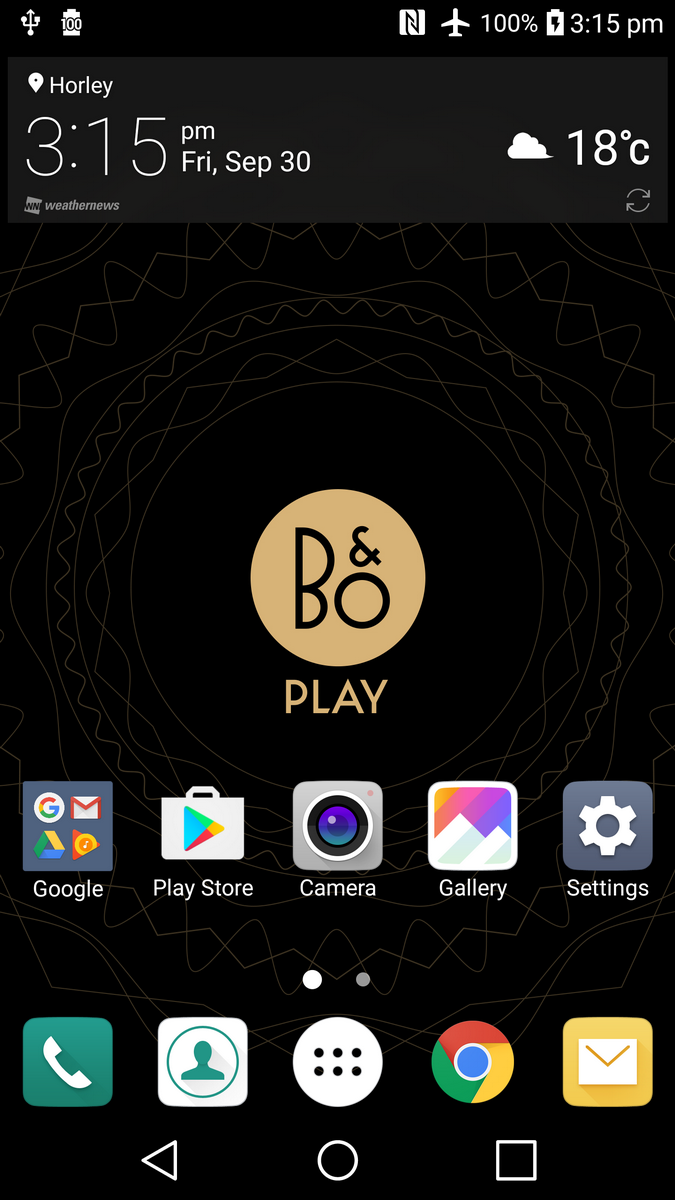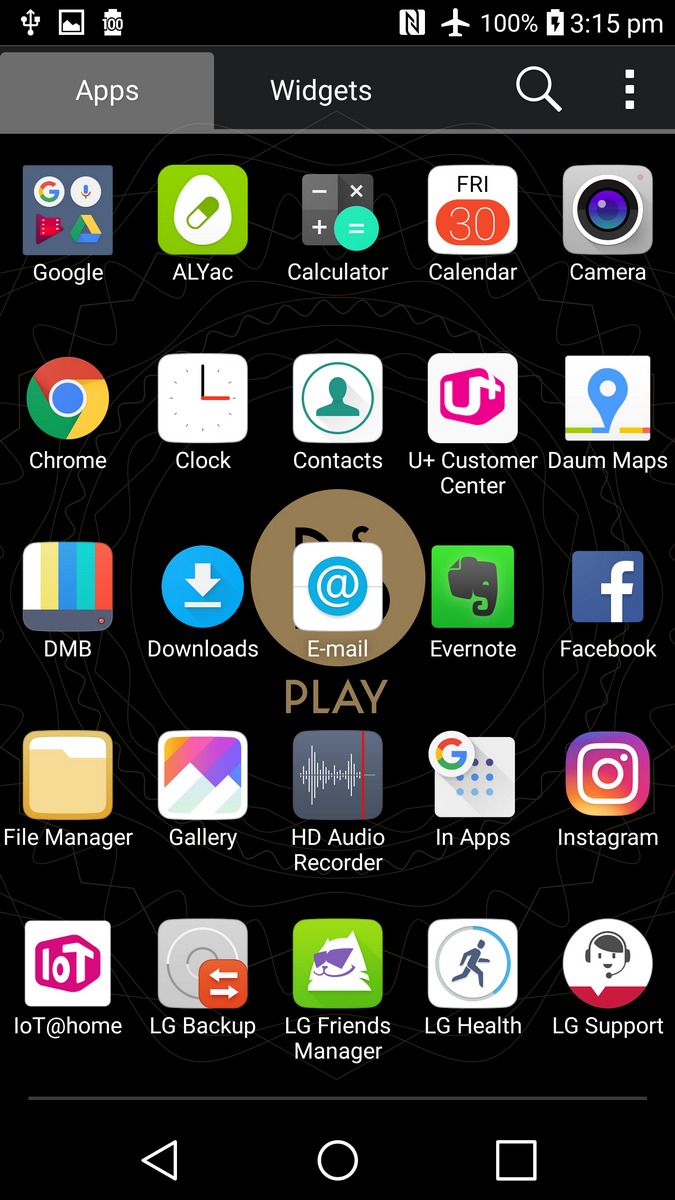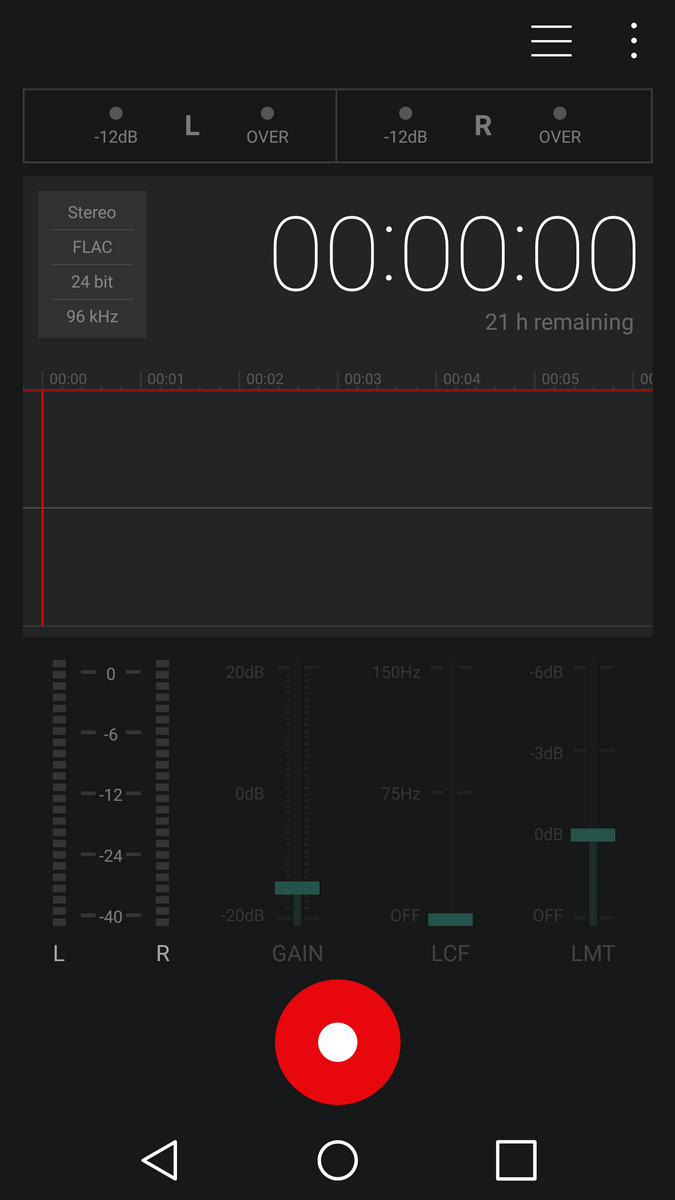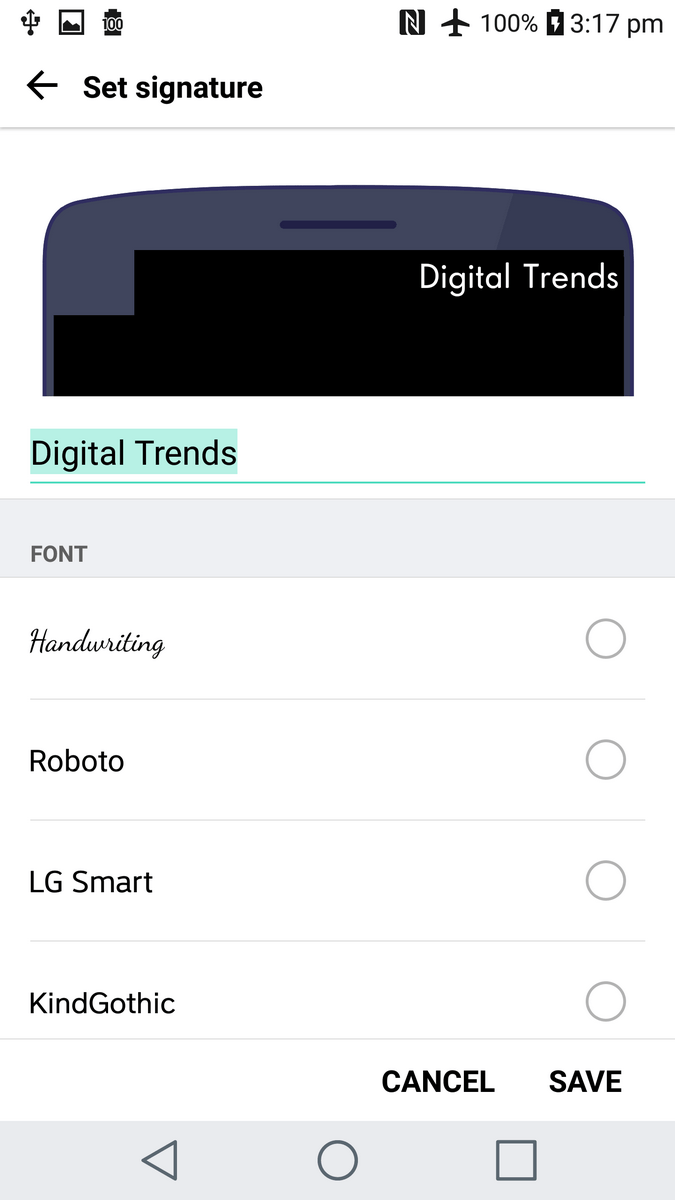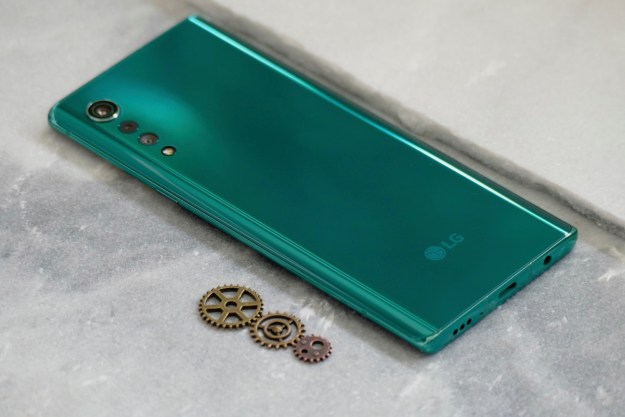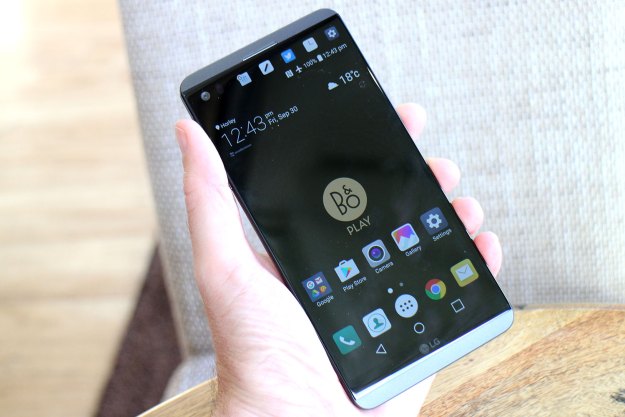
“Whether it’s taking sexy selfies or scenic landscapes, the LG V20 is the camera phone for the job.”
- Exceptional cameras
- Sleek, tough metal body
- Removable battery
- Android 7.0 installed
- Excellent audio performance
- Second screen works well for notifications
- Not waterproof
- B&O certification not available in the U.S.
- Unlocked version may not work outside U.S and Korea
The LG V10 was a big, brutish, and brilliant phone from last year, but it didn’t appeal to everyone in the same way Samsung’s Galaxy Note 5, or Apple’s iPhone 6S Plus did. It was a bit too ugly and bulky for most people. Now we have the LG V20 and it couldn’t look more different. The unusual textures, challenging body shape, and massive weight that singled the V10 out have all gone. We’re left with a svelte, lightweight stunner more in keeping with LG’s recent minimalist obsession that started with the LG G5.
LG really needs a phone that people adore, and want to rush out and buy. The G5 is just a bit too subtle, and its modular system of add-on components is not quite fully able to wow the masses. Can the LG V20 step up to the plate and hit a homerun for LG? We’ve spent a couple of weeks with it to find out.
Open me up, and you’ll see the battery
The LG V20 has an aluminum shell, but it’s not a unibody design like so many of its rivals — there are very well disguised, and very hard wearing plastic end plates for a start. Then, when you look at it from the back, there’s a button on the left side that pops open the rear cover to reveal a removable battery. Try doing that with any other metal phone (except the LG G5, actually) and you’ll regret it. Although it’s removeable, the V20’s metal cover is solid, and it won’t bend or break without some serious pressure, and it’s very easy to put back into place. There’s also a MicroSD card slot, and a single SIM card slot.
With the V20’s innards exposed, you can take out the 3,200mAh battery and potentially put another fully charged one in its place. That’s a rarity for flagship phones these days. There was a time when having a removable battery was a necessity, and many people sorely missed the option to pop in a fresh battery when closed unibody designs started to take over. While it’s great for some hardcore phone fans, others will be quite used to charging their phone daily, or carrying around a battery pack for recharging on-the-go. It’s not a must-have anymore.
The V20 is a bad-ass camera phone that rivals, and in some areas, surpasses the competition.
LG reinforced the V20’s body to meet MIL-STD-810G drop test and toughness standards, but don’t expect it to be all covered in rubber, or think as a brick. It’s only 7.6mm thick, and weighs 174 grams — which is very thin and light. It’s close enough to the Note 7 and iPhone 7 Plus that the differences are negligible. However, it loses points by not being water resistant, a consequence of the removable battery. Returning to how we feel about the replaceable battery, which only benefits some, we’d almost prefer the water resistance instead.
Our review phone came in the fetching ‘titan’ color, a dark steel grey, almost black hue. The design is let down by the camera bump on the rear panel. It’s especially large because of the two camera lenses, flash unit, and laser autofocus system it must house; but it’s not blended into the frame like the G5. It’s not drastically ugly, but the rest of the body is so uncluttered it stands out more than usual.
Wide angle cameras
The V10 had a wide-angle selfie cam, while the G5 has a wide-angle rear camera. The V20 brings both wide-angle cameras together on one phone. The V20 is a bad-ass camera phone that rivals and in some areas, surpasses the Galaxy S7 and the iPhone 6S Plus. The jury’s still out on how it ranks against the iPhone 7 Plus, but it compares very closely on paper.
On the back is the same setup as the G5, which means a 16-megapixel f/1.8 aperture cam for regular pictures, and a slightly lower-res 8-megapixel for the wide-angle shots. Regardless of which camera you use, they’re glorious. It’s as simple as that. On a sunny day, using the wide lens, the V20 produces vivid colors, extensive detail, and a beautiful landscape view. It takes some practice to frame shots like this, but get it right and you can minimise the slight fisheye effect that comes with the lens. Other times, the fish-eye adds a different and rather stylish dimension to your pictures.
Get close up to anything with the stock lens, and a wonderful depth-of-field can be captured, all without any software help, or a camera lens setup that’s optimised for it. Again, the colors and detail are exceptional, and it’s a pleasure to use. There’s a manual mode for the hardcore, but for once, I really didn’t feel the need to mess around with the settings under normal circumstances. Only for night shots — when a tripod is essential — was it necessary. There’s also a panorama, slow-motion shot, and LG’s weird pop-out picture mode, where you can add bizarre mosaic effects to an image. We love the G5’s camera, and equally love the V20’s camera too.
Swap to the front camera and you’ll notice that this time, there’s only one lens. However, it still manages to capture the same wide angle selfies as the V10. Whether you want to fit in a lot of friends, or a stunning vista without obscuring it with your face, it works superbly. The beauty mode helps smooth out lines and facial imperfections, but you’ll need to turn it down unless you want to look as though you’re made of plastic.
Recording video is also a pleasure, and the wide-angle selfie lens makes for some really excellent opportunities for live streaming. Only Full HD quality is available on the front cam, but UHD or Full HD at 60fps is available on the rear. LG’s highly capable HDR mode can be used front and rear as well. Regardless of the camera you choose on the V20, you’re assured of a stunning end result. It’s also the number one reason to buy the phone.
Two screens
The V10 introduced the concept of a second display on an LG phone. It’s a small display above the main screen, designed for quick access buttons, and showing notifications and alerts. By removing the second selfie camera lens on the V20, LG has widened the screen to 2.1-inches, and increased the resolution to 160 x 1,040 pixels. Has it widened its usefulness?
You decide what you want to see on the second screen. There’s space for five shortcuts of your choice, a customizable signature screen, and some quick access shortcuts to functions such as Bluetooth, the flashlight, and Wi-Fi. Outside of this, it’s really helpful for notifications. They’re visible when you’re in other apps or playing games, and crucially don’t obscure the main screen. It’s a big bonus, and the first time you glance at a message and register what it says, without being frustrated that the notification got in the way, it’s something of a revelation.
The V20’s primary display is a big 5.7-inch IPS LCD with a 2,560 x 1,440 pixel resolution, and it matches the experience we had on the V10 and on the G5, but the latter’s smaller size makes it appear even sharper. You’ll still never be left wanting for color, clarity, or contrast, plus it’s packed with detail as you’d expect from a resolution that high. The big screen certainly makes the photos taken with the phone look superb, but it’s too big for comfortable one-handed use, despite the phone’s slim body.
Listen up
The V20 has considerable musical talents. It’s the first to come with a Quad-DAC, while the V10 had a 32-bit single DAC. What does this mean if you’re not an audiophile? Well, it’s supposed to make your music sound better. You can turn it on and off, so you can establish if you can hear any difference. The answer will depend on your ears, your headphones, your choice of music, and your listening environment. In other words, you may not notice straight away.
Listening over a pair of B&O Play H8 headphones (with the wired, rather than Bluetooth connection), music is brighter, the bass ever so slightly deeper, and the sound stage more expansive with the Quad-DAC active. We’re talking about a relatively subtle change, but noticeable enough you’ll want to leave the Quad-DAC switched on. There was some sharpness to the treble occasionally, especially with high-pitched vocals, but it wasn’t unpleasant. The second display is also handy when you’re listening to music, as the app shows up with simple controls even when the screen is locked and dark.
There’s a reason we chose B&O Play headphones to audition the V20, because Bang & Olufsen has certified the audio prowess of the phone, and you’ll find its branding on the device itself. At least you will if you’re not buying the V20 in the U.S., where it doesn’t have B&O’s approval. It’s a bizarre decision, but it’s not the first time we’ve heard such madness from LG. The best module available for the G5 is the Hi-Fi Plus, made with B&O, which also can’t be purchased in the States.
The B&O certification isn’t a feature as such, more a series of tests and tweaks carried out by audio engineers to ensure a natural sound from the phone. The Quad DAC is going to have the greatest effect on the quality of sound, and a V20 without B&O certification is likely to just sound a little different, rather than better or worse. Once we’ve listened to the U.S. model, we’ll update this review.
Unplug the headphones and the V20’s speaker is loud and clear, but there’s only one at the bottom of the device. Even Apple has realised the importance of a stereo speaker setup in a phone, so it’s a shame there’s only one here, especially as it sounds so good with headphones on. It’s not quiet though, and whether it’s games or video playing, there’s plenty of power behind the V20’s sound.
Perhaps you’re into making music, just as much as listening to it? The V20 has an HD Audio Recorder app and a very clever array of microphones, so you can record your voice, sing against a backing track, or even record concerts or other musical events. While we opted out of warbling away to test it out, we recorded a few conversations to hear the difference. It was impressive, and the ability to save files in a hi-res FLAC or WAV format helped a lot. In a back-to-back test with the iPhone 7 Plus, the V20 wiped the floor with Apple’s standard Voice Memos app, utterly removing background hiss, capturing voices realistically, and at a reasonable, natural volume. If an audition for the X Factor beckons, you’ll want to record it on the LG V20.
Software and performance
Android 7.0 Nougat is pre-installed on the LG V20, and it’s the first phone to come with the very latest version of Google’s operating system. Many of the alterations in Nougat are very subtle. For example, a short drag on the notification shade shows some quick shortcuts (but they’re mostly available in the V20’s second screen anyway), plus you can swap between the two most recently used apps with a double tap of the Recent key. However, the split-screen apps feature wasn’t present on our V20, and it wasn’t replaced by one of LG’s own either, strangely.
An excellent side benefit of having Android 7.0 installed at launch is that you won’t have to wait around for the update to come though like you will with almost every other Android phone out there at the moment. Right now, you can’t get any more up to date with an Android phone than the V20. In the future, updates will come when LG releases them, and like every other manufacturer that’s not always very timely. That’s an issue when it comes to security patches.
There’s no complaints regarding speed and overall performance here. A Qualcomm Snapdragon 820 processor with 4GB of RAM powers the phone, matching the Galaxy Note 7 and the Galaxy S7. Playing Danmaku Unlimited in HD, on both normal and hard mode, didn’t reveal any slowdown. The display is quite sensitive though, often picking up slight touches as prominent taps to open apps, and the auto-rotation often got confused and became a pain.
Battery life is good, but sometimes inconsistent. Shooting HD video, including many pauses with the screen still lit up, barely had any impact on the percentage shown on screen. Play some games though, and that quickly changes, resulting in a faster drain. However, we still found two days of regular use is possible, or a day and a half maximum if you use it more solidly.
That’s slightly better than what you’d get with the Samsung Galaxy S7 Edge or the iPhone 7 Plus.
Warranty and availability
LG gives you a one-year warranty on the V20, and it covers either repair or replacement, plus any labor charges. You’ll have to send it back to the company if it goes wrong though.
If a big-screen Android phone is what you want, the LG V20 is the one to buy.
If you’re itching to buy the V20, then you’ll need some patience. LG hasn’t revealed which carriers will sell it in the U.S., how much it will cost, or even the exact date it’ll go on sale. What we do know is it’s coming in the latter part of October.
We’ve already mentioned the U.S. LG V20 doesn’t have B&O certification, but that’s not where the V20’s sales problems stop. If you’re in the U.S., South Korea, or selected other countries, the phone will be available to buy. If you’re in the U.K., or some other European countries, then you’re out of luck because LG won’t sell you a V20.
Even if the B&O certification is tempting, don’t bother importing one, either. The model we tested here was designed for the UPlus network in Korea, and wouldn’t accept any U.K. SIM at all, despite being theoretically unlocked. It’s possible a Korean phone may suffer from the same problems for would-be U.S. importers. This also raises concerns regarding the unlocked nature of the U.S. phone, and whether travelers should be wary it may not work with an international SIM card. LG told us it’s possible U.S. phones will be locked, but it’ll be the carrier’s decision.
Conclusion
LG’s decision to not sell the V20 globally and limit B&O certification to certain areas sours what would be a sweet deal. What’s doubly annoying is that it’s a very, very good time to sell a big-screen smartphone. Samsung’s hit quite a snag with the exploding Galaxy Note 7, and LG is missing out on stealing away some potentially disillusioned, previously dedicated Samsung fans by not selling the V20 everywhere. We can’t recommend buying the Note 7 right at this moment, but that’s sure to change in the near future, leaving the new iPhone 7 Plus as the V20’s natural competitor until that happens.
That said, the V20’s cameras are superb, the second screen is better and more helpful than the V10’s version, and the audio — whether it’s recorded on the phone or played back — is wonderful. It’s a shame the tough body isn’t waterproof, but the V20’s removable battery is unique and may sway a buying decision for some. We also welcome an entirely up to date build of Android installed right from the start. If a big-screen Android phone is what you want, the LG V20 is the one to buy (assuming “must explode” isn’t on your list of desirable features).
However, while the V20 is excellent, outside of the big screen experience and wide-angle camera, it’s not leaps and bounds ahead of slightly smaller and equally great phones such as the Galaxy S7 Edge and even the G5. The big-name smartphones in 2016 have been almost universally superb, and the V20 is another to add to the list.
This isn’t a bad thing, it’s great we have so many awesome phones to buy, but it makes the decision on which one rather hard. At the end of the day, this is our final judgement: For the person with an unlimited budget on the quest for a big-screen smartphone and stuck between the V20, a flaming Note 7, and the iPhone 7 Plus; buy the iPhone. Unless you hate Apple. In which, case, the V20 it is!
Editors' Recommendations
- LG shows off optical zoom lens module that banishes the bump
- Vivo’s V23 5G looks quite a lot like the iPhone 13
- Samsung Galaxy S20 Plus vs. Google Pixel 4 XL: Which big phone wins?
- The best Samsung Galaxy S20 screen protectors
- The best Samsung Galaxy S20 Ultra screen protectors









